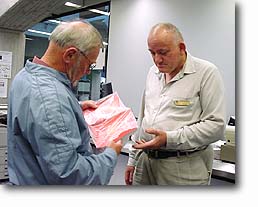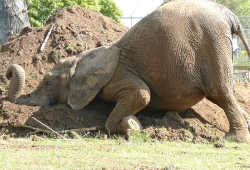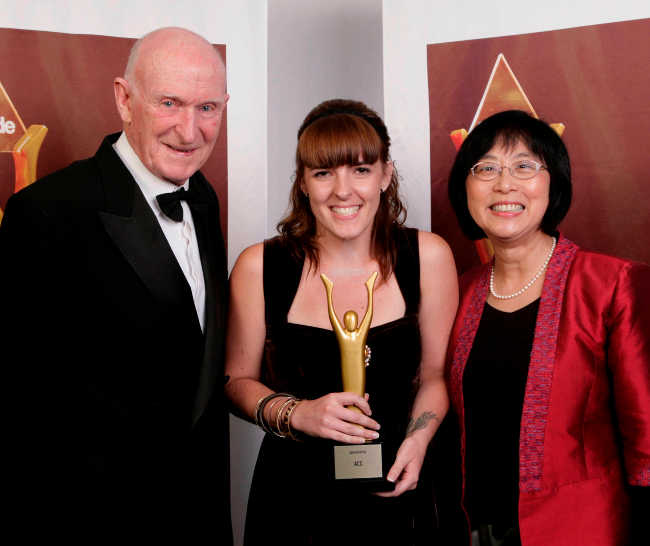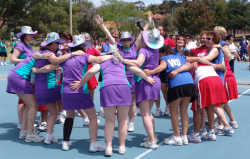Family historian and librarian
Dorothy – 29/03/02
Richard Greenaway is the person you are most likely to talk to if you are interested in genealogy or the early history of Canterbury and go to the Aotearoa New Zealand Centre at Christchurch City Libraries (CCL) – formerly Canterbury Public Library. The early history of Christchurch is a subject in which he is passionately interested and when he helps you seek for information he makes you feel that he is as keen to find to answer as you are.
History a lifelong interest The school years When he was about ten Richard used to spend long hours in the library finding out about ancient Egypt, Greece and Rome, and he chose this subject for a project in his final year at Burwood primary school, writing a volume rather than the required number of words! He was also fascinated by the reigns of all the kings and queens of England, memorising their dates from 1066 onwards. His retentive memory for dates was going to prove a great asset in his later career. History, English, French and German were the subjects he majored in while at Shirley Boys’ High School.
Masters degree at the University of Canterbury After completing a B.A. in English and history at the University of Canterbury, for his Masters degree in history he wrote a thesis on “Henry Selfe Selfe and the Origins and Early Development of Canterbury”.
This unusual name seems to have resulted from the requirement of his grandmother, Mrs Selfe, for him to change his name from Henry Selfe Page to Henry Selfe Selfe, taking her name in order to inherit money.
H. S. Selfe was a member of the Canterbury Association and was the English Agent for Canterbury so from 1856 to 1866 he did whatever work in England the Government, the Church and the Education System required. He died in 1870. His son gave all his correspondence to Dr Hocken of the Hocken library and photocopies of the letters were sent in 1970 to the Canterbury Museum.
|
|
| Richard Greenaway receives from Peter Law a book donated to the Aotearoa New Zealand Centre |
Library work Richard worked for two years at the Hocken Library as archives assistant assisting Stuart Strachan and Peter Miller and with this experience as a qualification he was able to attend the New Zealand Library School in 1979 and in March 1980 he was appointed as archivist at the Canterbury Public Library.
Increased community interest in genealogy With the growth in interest in genealogy Richard was appointed to take charge of the genealogy services. He took over the correspondence in 1980 and there were eighty five letters that year related to genealogy. Now each year there are two to three hundred letters plus numerous emails.
Fees for correspondence At first there was no charge for the service, but now there is a fee for genealogical services as they take so much staff time. An inquiry on a large nineteenth century family can easily take up to four hours.
Written requests for information are charged if they take staff time for research. Correspondents are given an estimate of the cost before the requested work is done. CCL charges $20.00 per half hour, payable in advance, seeks payment by cheque and cannot accept payment by bank card. Overseas researchers are asked to pay by bank draft made out in New Zealand dollars.
What sort of people are interested in genealogy? Richard challenges the view that genealogists are all elderly and somewhat infirm – people who take up genealogy when they are not fit enough to take up any other hobby. He says that as people have the time to research their family history in their retirement there are a good number of older people interested in genealogy, but he receives inquiries from people of all ages from sixteen years upward. Those who start their research when young have a much wider range of information sources available. It is more common for people to become interested at a later stage in their lives when the people who could have answered their questions have died.
CCL’s genealogy services Church register transcripts At the end of 1980 Richard initiated the church register project with its transcripts of baptisms, marriages and burials for Christchurch and its environs. As Canterbury was a Church of England settlement, the strongest emphasis is on the Anglican church. Richard describes the scheme, which continues today, as producing “extensive though not comprehensive transcripts in card and in book form”.
Now the register has transcripts from some Wesleyan, Presbyterian, Lutheran, and Roman Catholic churches, from Trinity Congregational Church and from the Oxford Terrace Baptist Church marriage register. They cover the years from the 1840s to the 1920s.
Microfiche and microfilm collection There is now a microfiche and microfilm collection, a separate sub-collection within the Aotearoa New Zealand Centre. The basic information for genealogy research is held there and genealogists go to Richard and the other librarians who staff the main desk when there is a query about a difficulty or something strange in the research.
The Registrar-General, Births, deaths and marriages, Department of Internal Affairs, Lower Hutt, has produced a microfiche index to his records from the 1840s to 1990. This can be seen at CCL, most other big libraries and Mormon family history centres. Till recent years people who could provide precise details from this source – the name, year and number – could purchase a certificate for $NZ 9.00 but the Government has increased that cost to
$NZ30.00.
The district keys to the New Zealand registration districts Books called the District keys to the New Zealand registration districts are associated with the birth and death fiche up till 1955. From the books you can work out where births and deaths were registered and, if your family was associated with a particular area, whether a particular individual is likely to have been one of your relatives.
Using these indexes I asked Richard how I would make best use of these sources. I quote his reply.
“The index to births, deaths and marriages covers the period from the 1840s to 1990 and enables a person to track down the years in which events occurred. Remember that the birth, death and marriage entry for each person (or, in the case of a marriage, a couple) is unique. Only one couple have the marriage entry 676 for the year 1873.
“James Gapes married Alice Swindell in 1873. When I look up James Gapes among the ‘G’ men, I find the number 676. When I look up Alice Swindell among the ‘S’ women, I find the number 676.
“If I know that James Gapes was a relative, but I do not know the name of the person whom he married, I can purchase a copy of a marriage certificate; join the New Zealand Society of Genealogists which has a ‘Matching brides and grooms’ service; or I can go through every person of the opposite sex till I find a woman who has the number 676.
“From the late 1950s a man has, beside his name both the appropriate number and the surname of the person whom he married. One then simply looks up the appropriate surname in the women’s column and finds the lady with the correct number.
“With regard to the District keys to the New Zealand registration districts: these relate to births and deaths (but not marriages) and show where in New Zealand these were registered in each year. Cities, towns and suburbs are listed on the left side of the page with columns for the four quarters of the year. Everybody from one number to the number before the next number down was registered in the town whose name is to the left.
“Let us take New Brighton. The Hawkers and their relatives, the Smiths, lived in the seaside town for a great number of years. We will assume that I know the years when the Hawkers and Smiths might have started and ceased having children but that I am ignorant of the Christian names of the children, when they were born and whether any of the siblings died in infancy or childhood.
“If I go through the index to births and deaths for the appropriate years and pick out all the Hawkers and Smiths, I can then go to the District keys and work out which people were registered in New Brighton. Thus I can eliminate the people who are irrelevant to my search. I should remember that there may be more than one unrelated family in an area, particularly when the surname is a common one.
“The index to births can be useful for nailing down when a birth notice may have appeared in the newspaper. However, in the 19th and early 20th centuries, birth notices were not particularly common. The index to deaths is useful for showing the quarter of the year in which a death occurred and, thus, when newspaper death and funeral notices might appear. These have always been more common than birth notices.
“You can check out the index to births, deaths and marriages in the articles which I wrote in Bookmark in 1999. “
List of the women on the 1893 Electoral Roll A woman’s name can be found on this roll which is on microfiche.
General electoral roll Having found a woman’s name, it is possible trace her and the male members of the family on the general electoral roll which is on microfilm. This will state where the people were living at that time although the addresses may be rather vague.
Index of bankruptcies This is on microfiche and includes information about when the bankruptcy was published in the newspaper. For instance this gave information and dates for the bankruptcy of Allan Hopkins whose story is included in Richard’s book, Rich man, poor man, environmentalist, thief. This made it easier to find the newspaper accounts of this bankruptcy which was of great public interest.
Archives New Zealand, 90 Peterborough St, holds the information about bankruptcies in Canterbury. For Christchurch they cover the years from 1863 to 1996; for Timaru 1863 to 1977
For Allan Hopkins there were three boxes of documents for Richard to sift through for additional personal information. Allan Hopkins went bankrupt in 1921 but some of the correspondence in his file dates from as late as the 1950s.
There are also two microfiche items by Denis Hampton: An index to bankruptcies in Canterbury 1853-80 An index to the bankruptcies in New Zealand 1881-1940
Denis Hampton gave a talk on the subject to the year 2000 conference of the New Zealand Society of Genealogists. This appears in the published conference papers which have the title Bound for Canterbury 2000.
Wills Archives New Zealand also holds the wills of Cantabrians from the 1850s to the 1980s although the early Public Trust wills are not all there. They are held in Wellington.
Shipping Lists These are held at the Canterbury Museum. Archives New Zealand hold only photocopies of lists of assisted immigrants for a period in the 19 Century.
Biographies The Alexander Turnbull Library in Wellington holds biographical material created in the period from 1920 to the 1980s. This is drawn from newspaper obituaries, interviews and historical articles. There are also references to the library’s correspondence.
The Privacy Act will not allow the library to say which of one’s relatives the library wrote to twenty or thirty years ago. However, the content of the letter – about a presumably long deceased common ancestor – can be made available. The dead have no privacy.
Police records CCL has a complete set of the Canterbury Police Gazette 1871 -77.
Police Christchurch Record Books – Communications Received and Despatched
These are held at Archives New Zealand and cover from 1878 to 1950. These letters deal with staff matters such as retirement and housing, and also crimes, criminals and prosecutions. These books were a valuable source of information for Richard’s article on ex-convict George Vennell and his ex-convict wife and also for the article on Allan Hopkins.
Anglican and Methodist Archives These also have useful material.
Books written for the CCL Unsung Heroines Articles about some spirited women living in Christchurch in the early years were published in CCL’s Bookmarks in 1993 to honour the centenary of Women’s Suffrage and the series was expanded and published as a small book, Unsung Heroines, in 1994. There is a wide range of heroines.
Isabella Williams, mother of seven, was widowed just after arrival in one of the First Four Ships, and supported the family by opening a small drapery business.
Bella Button was a skilled horsewoman who drove winners in a number of races in the 1890s until the South Island Trotting Association resolved that only men would be allowed to drive at meetings.
Annie Townend, the daughter of a hard-hearted wool baron, owned Mona Vale early in the twentieth century.
May Furey, a more recent ‘heroine’, cooked in the Australian outback, was a pianist for the silent films, a campaigner for peace and anti-nuclear groups, and in 1941 founded the Canterbury Housewives Union which campaigned for better conditions for women, less expensive food and better quality clothes.
Among the other ‘heroines’ are an early postmistress, a mother of twenty four children who feuded with the New Brighton Tramway Company, the owner of a city hotel, a cafe proprietor, and other women who struggled to be independent in difficult times.
Rich man, poor man, environmentalist, thief This book, written for the Millennium and for the 150th anniversary of the Canterbury Settlement, tells the life story of eight Canterbury personalities, a number connected with the eastern suburbs of Christchurch. Allan Hopkins built a home at Saltaire at North Brighton and lived the life of a rich man, but when he became bankrupt it was revealed that he was also a thief. Richard Bedward Owen was an outstanding environmentalist who was responsible for much of the tree planting and development of lawns along the banks of the Avon. Frederick Richardson Fuller, the first taxidermist at the Canterbury Museum, committed suicide, and his family struggled financially.
Other characters include a schoolmaster, the ice cream man in Cathedral Square, an ex-convict possibly murdered by his ex-convict wife, a woman who started the first high school for girls in Christchurch, and a man who not only worked tirelessly for temperance but also planted soil-binding species, especially lupins, along the shore at New Brighton.
The long list of information sources at the end of each story is clear evidence of the extensive research that was done before these stories were published.
I recommend both these books as really interesting reading.
Cemetery Tours In 1994 Richard was invited to conduct cemetery tours during Heritage Week outlining the history of some of the people buried there. He began with the Barbadoes Street cemetery where a number of prominent Cantabrians are buried. Since then he has conducted tours of the Burwood, Linwood, Avonside, St Peter’s, Addington and Waimairi cemeteries.
Richard is available to give cemetery tours to interested groups – churches, Rotary, Lions, Girl Guide captains, etc. – at Barbadoes Street and elsewhere in and out of Heritage Week.
Many people interested in genealogy or in early Canterbury history have benefited from Richard’s wide ranging research into the lives of the people who have fashioned Christchurch or sought to influence the thinking of its citizens since the mid nineteenth century.





